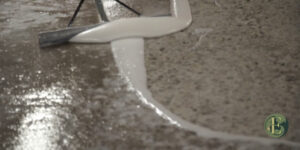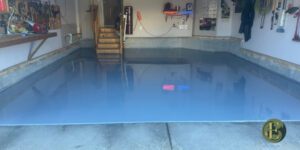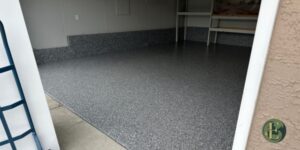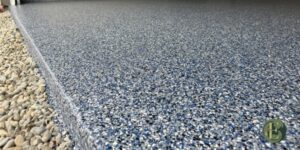When it comes to kitchen and bathroom upgrades, one feature that has gained tremendous popularity over the years is epoxy countertops. With a combination of aesthetic appeal, durability, and low-maintenance care, epoxy countertops offer homeowners an affordable way to create stunning, one-of-a-kind designs in their most frequently used spaces.
In this article, we’ll explore why epoxy countertops are an excellent option for both kitchens and bathrooms, how they compare to other materials, the installation process, and essential maintenance tips. Let’s dive into why epoxy countertops may be the perfect solution for your next home renovation project.
What Are Epoxy Countertops?
Epoxy countertops are surfaces that are coated with a specially formulated resin called epoxy. This material starts as a liquid and hardens to form a solid, durable layer that can be molded and customized to fit a wide range of design preferences. What makes epoxy unique is its versatility in design; it can mimic the appearance of high-end materials such as marble, granite, or quartz without the associated cost. Moreover, epoxy can be applied over existing countertop materials like laminate or concrete, making it a fantastic choice for those looking to give their space a facelift without a full replacement.
The Benefits of Epoxy Countertops

There are several reasons why epoxy countertops have become such a popular choice among homeowners. Here are the most notable benefits:
1. Aesthetic Appeal
One of the primary reasons epoxy countertops are so desirable is their ability to be customized. Whether you want a sleek, modern look or a luxurious marble-like finish, epoxy can be tinted, swirled, and mixed with different pigments to create any style you desire. You can even incorporate metallic powders, glitter, or unique patterns to make your countertops one-of-a-kind. The glossy finish that epoxy provides also adds a high-end touch to any kitchen or bathroom.
2. Low Maintenance
Epoxy countertops are remarkably low-maintenance, making them ideal for busy homeowners. Once installed, the surface is non-porous, which means it doesn’t easily absorb liquids, dirt, or bacteria. This makes it simple to clean with just a mild soap and water solution. Additionally, epoxy’s smooth surface is resistant to stains, so common kitchen or bathroom spills like coffee, wine, or toothpaste can be easily wiped away without leaving marks.
3. Durability and Longevity
Epoxy countertops are highly durable and resistant to damage. The resin creates a hard, resilient surface that is scratch-resistant and can withstand high levels of wear and tear, making it suitable for kitchens where sharp utensils and heavy pots are common. It’s also heat-resistant, which means you can place hot pans on it without fear of damaging the surface (although it’s always best to use a trivet or hot pad for extra protection).
With proper care, epoxy countertops can last for many years without needing to be replaced. The material’s resistance to cracking and chipping ensures a long lifespan, even in high-traffic areas like kitchens and bathrooms.
4. Cost-Effective Solution
Compared to other high-end countertop materials like marble, quartz, or granite, epoxy is significantly more affordable. The ability to create a custom, luxury look without the hefty price tag makes epoxy an attractive option for homeowners on a budget. Plus, since it can be applied over existing countertops, the installation process is often quicker and less expensive than a full countertop replacement.
5. Seamless Finish
Epoxy countertops offer a seamless, continuous surface without grout lines or joints, which can be a breeding ground for dirt and bacteria. This seamless design not only adds to the sleek appearance but also makes cleaning more effortless and hygienic.
Installation Process of Epoxy Countertops

Epoxy countertops can be a DIY project for experienced homeowners, but many prefer to hire professionals for the installation process. Here’s a brief overview of the steps involved in creating epoxy countertops:
1. Preparation
The first step in the process is preparing the existing countertop. This involves cleaning and sanding the surface to ensure proper adhesion of the epoxy. If there are any cracks, holes, or damage in the existing countertop, they will need to be repaired before the epoxy is applied.
2. Priming the Surface
Once the countertop is prepped, a primer coat is applied to the surface. This helps the epoxy resin adhere properly and enhances the overall finish. The primer also serves as a base for any colors or patterns that will be added.
3. Mixing and Applying the Epoxy
The next step is mixing the epoxy resin with hardener and any desired pigments. This mixture is poured over the countertop and spread evenly using a trowel or roller. Depending on the design, various tools or techniques may be used to create unique patterns or effects, such as marble veining or metallic swirls.
4. Curing Process
Once the epoxy is applied, it needs time to cure and harden. This process can take anywhere from 24 to 72 hours, depending on the product used and environmental conditions. It’s important to keep the area free of dust or debris during this time to ensure a smooth, flawless finish.
5. Final Finishing
After the epoxy has fully cured, a topcoat can be applied for extra protection and a high-gloss finish. This final layer helps to enhance the durability of the countertop and gives it that beautiful, polished appearance.
Comparing Epoxy to Other Countertop Materials
When deciding whether epoxy countertops are right for your home, it’s helpful to compare them to other popular materials:
- Granite: Granite is a natural stone that offers unique patterns and colors, but it requires sealing to prevent stains and bacteria growth. Epoxy can mimic the look of granite but is more affordable and doesn’t require sealing.
- Quartz: Quartz countertops are known for their durability and non-porous surface. While they are low-maintenance like epoxy, they tend to be more expensive and have fewer customization options.
- Laminate: Laminate countertops are affordable but prone to scratching and staining over time. Epoxy can be applied over laminate to provide a more durable, updated look without the cost of replacing the countertops entirely.
Maintenance Tips for Epoxy Countertops

While epoxy countertops are low-maintenance, there are a few tips to keep them looking their best for years to come:
- Regular Cleaning: Clean your epoxy countertops regularly with a soft cloth and mild soap. Avoid using harsh chemicals or abrasive pads that could damage the surface.
- Use Cutting Boards and Trivets: Although epoxy is heat-resistant and scratch-resistant, it’s always a good idea to use cutting boards and trivets to prevent any accidental damage.
- Polishing: Over time, the glossy finish may lose some of its luster. You can restore the shine by using a gentle polishing compound made specifically for epoxy surfaces.
- Avoid Standing Water: While epoxy is water-resistant, standing water can cause discoloration over time. Be sure to wipe up any spills promptly to maintain the surface’s appearance.
Is Epoxy Right for Your Kitchen or Bathroom?

Epoxy countertops are an excellent choice for homeowners looking to achieve a high-end look on a budget. With their customization options, durability, and low-maintenance care, epoxy surfaces can transform your kitchen or bathroom into a stunning, functional space. Whether you’re renovating your home or simply looking for an upgrade, epoxy countertops provide a beautiful, cost-effective solution that’s built to last.
For more information on installing epoxy countertops or to explore the latest design trends, reach out to a local epoxy installation expert to discuss how this versatile material can elevate your home.







